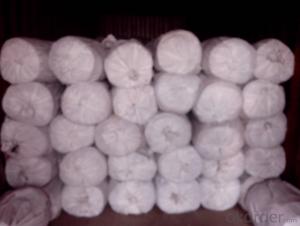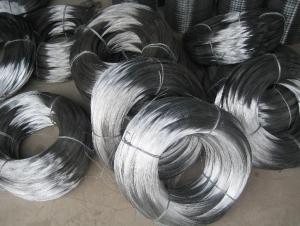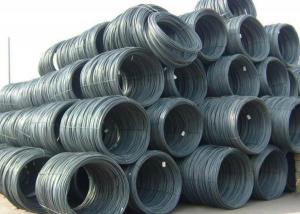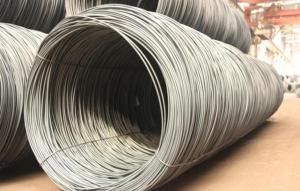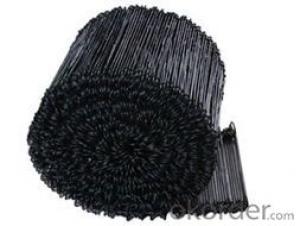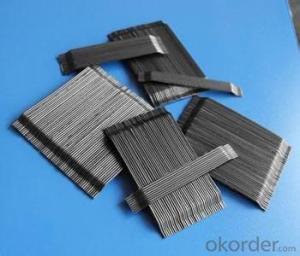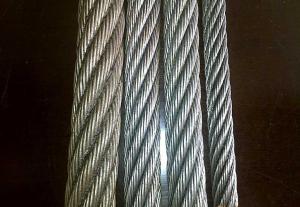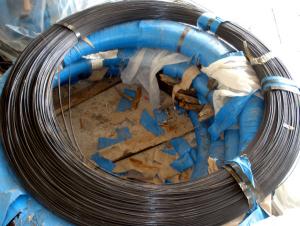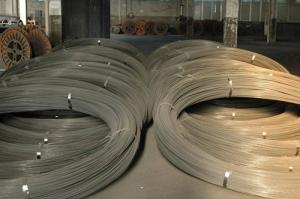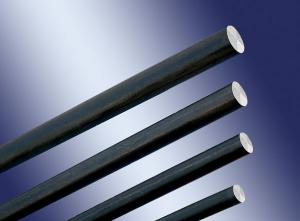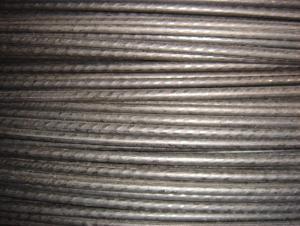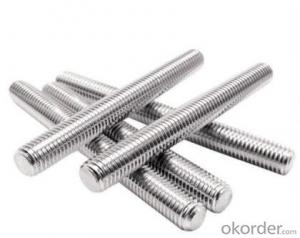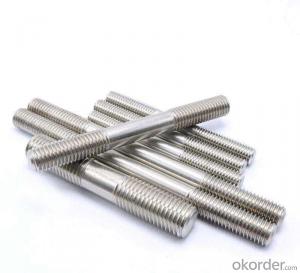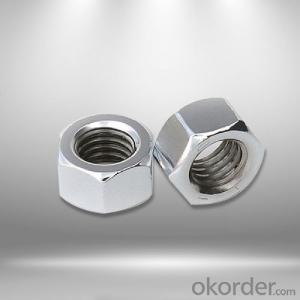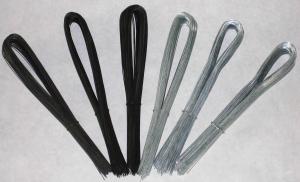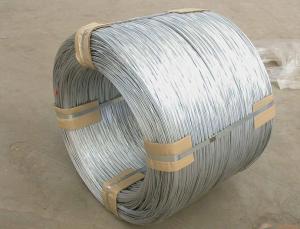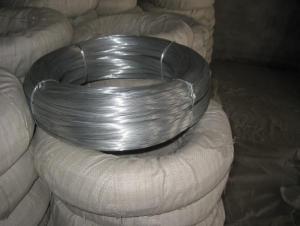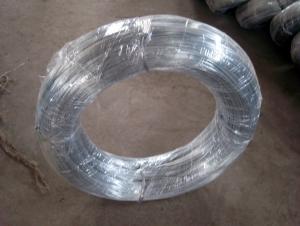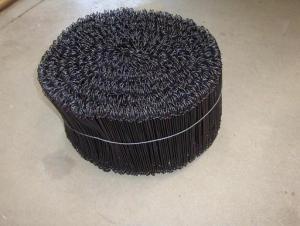Galvanized Binding Iron Wire Bale Tie Wire Bag Ties
- Loading Port:
- China main port
- Payment Terms:
- TT or LC
- Min Order Qty:
- 20 PCS
- Supply Capability:
- 50000 PCS/month
OKorder Service Pledge
OKorder Financial Service
You Might Also Like
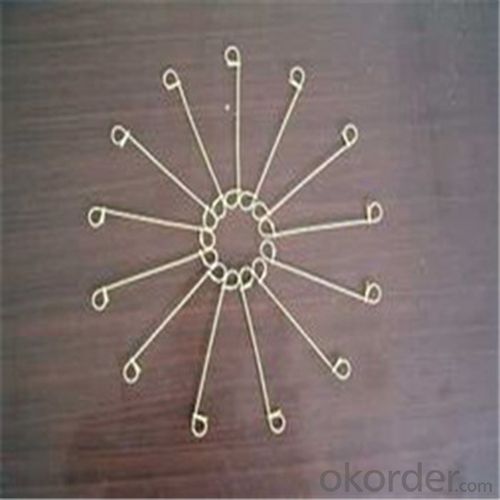
1. Wire gauge: SWG0.71mm - 4.06mm
2. Electro galvanized wire zinc coat: 10g/m2 - 15g/m2
3. Surface treatment of galvanized iron wire: electro galvanized or hot dipped coating
4. Tensile strength:350-600Mpa
5. Coil weight:25-800kg,as customers' requiryment.
6. Application of galvanized wire:
Galvanized Wire is widely used as binding wire in gardens, daily life, handicrafts and certain industrial uses.
Securing trees, vines and creepers to supporting trellises, or even erecting and joining supporting structures.
Tying bags for grain potatoes, wood, lime, coal, seed, chemical, etc., or even as a mail or laundry bag seal.
Bundling products of wire, rod, wood tube and cane.
An inexpensive packaging for storage or quantity control and for binding line wire to fence posts or securing mesh to line wires or even repairs.
Fixing or reinforcing steel for buildings, swimming pools, etc
Packaging of carpets, fabrics, etc., for storage and dispatch.
7. Common specifications of galvanized wire:
Guage | SWG(mm) | BWG(mm) |
8 | 4.05 | 4.19 |
9 | 3.66 | 3.76 |
10 | 3.25 | 3.40 |
11 | 2.95 | 3.05 |
12 | 2.64 | 2.77 |
13 | 2.34 | 2.41 |
14 | 2.03 | 2.11 |
15 | 1.83 | 1.83 |
16 | 1.63 | 1.65 |
17 | 1.42 | 1.47 |
18 | 1.22 | 1.25 |
19 | 1.02 | 1.07 |
20 | 0.91 | 0.84 |
21 | 0.81 | 0.81 |
22 | 0.71 | 0.71 |
- Q:why is neutral wire.explain plz
- in case you're speaking with regard to the cord from the ceiling to the wall swap, that's the place you interrupt the flexibility going to the ceiling container. If there is basically one cord and that's warm, its the cord that comes from the flexibility source and you nevertheless could desire to run one as much as the ceiling to end the transport of ability. there is not any could desire to swap the impartial cord, so it would not get run right down to the swap, basically the nice and comfortable/black cord. What does the ceiling have? If there's a black cord that's no longer stay, and a white cord, then perhaps your black cord to the ceiling from the swap has been pulled out of the swap container. do away with the container and dig around and notice in case you will locate it. turn off the optimum mutually as you do it, as you do no longer understand what is going on yet with the circuits.
- Q:how to wire a receptacle with 6 wires?
- Loosen the wire clamp screws located on the sides of the receptacle there are 2 kinds of clamp screws on a receptacle one set is silver and the other is brass colored.....Put the 2 Neutral (white) wires on the side where the Silver screw clamps are and tighten each one down....put the 2 Positive (black) wires on the side where the brass screw clamps are at and tighten each one down...That leaves you with 2 wires left.......You will need an extra 4 inch long piece of ground wire so use your spool and cut a 4 inch piece of green wire or bare copper wire, this is called a pig tail....you will need a green wire cap...take the 2 ground wires and the 4 inch pig tail and hold the ends together evenly and then screw on the green wire cap nice and tight....this leaves you with a single pig tail wire coming out the green wire cap, this wire is then connected to the small ground screw on the receptacle....then gently fold wires and place everything into the outlet box nice and neat....
- Q:how to connect the wiring from car stereo to amplifier
- You will need an RCA cable from the amp to the stereo, as well as a small (usually blue and white) remote wire from the amp to the stereo. The RCA cable ends usually plug in to the back of the stereo just with regular plugs, but you may have to hard wire them in. As for the remote wire, you will have to hard wire it in. Whether it be by soldering, wrapping it around the existing and taping, or using a snap connector. You will also need a power wire for the amp and a ground wire.
- Q:Hello everyone! I have what is probably a very simple question.I'm not exactly a radio expert. So my question is this:Is there a difference between copper wire and antenna wire (copper as well)?
- For frequencies up to about 100 megahertz, any kind of wire will work, but it will not look very professional if you use, multi conductor cable with all the conductors connected at both ends. Over 100 feet between supports, it may not be strong enough in a high wind. Above about 100 megahertz 1/4 inch steel wire may work well if it is copper plated = most of the current travels near the surface = skin effect. The antenna wire is possibly hard drawn for extra strength. The cable between the radio and the antenna needs to good quality if this is a long distance, even at less than 100 megahertz Neil
- Q:Two steel wires are stretched with the same tension. The first wire has a diameter of 6.00E-4 m and the second wire has a diameter of 8.90E-4 m. If the speed of waves traveling along the first wire is 53.2 m/s, what is the speed of waves traveling along the second wire?
- Wave velocity v = √(T/μ) Same tension in both wires: T1 = T2 μ is the linear mass density v1 = 53.2 m/s v2 = ? = v1/v2 = √(T1/μ1) / √(T2/μ2) = √(T1μ2 / T2μ1) = √(T1/T2 * μ2/μ1) = √(μ2/μ1) Linear mass density is mass/length, mass is density*volume: m/L = ρV/L = ρAL/L = ρA = ρπr^2 Both wires are steel so their density is the same. == v1/v2 = √(μ2/μ1) = √(ρπr2^2 / ρπr1^2) = √(r2^2 / r1^2) = r2/r1 == v2 = v1r1/r2 = (53.2*3.00×10^-4) / 4.45×10^-4 = 35.9 m/s ---- Speed of waves along the second wire is 35.9 m/s
- Q:I just bought a set of performance sparkplug wires for my 2001 Chevy Cavalier. I went to install them and my engine is now misfiring like one of the wires in not connected. I have made sure all of the wires are on tight and in place. The wires did not come numbered so i just put them on according to size. What could be the problem???
- It sounds like you may have installed the wires out of order. On your car the firing order is 1-3-4-2; standing at the front of the car the cylinder count is from passenger side to driver side (#1 is passenger; then 2-3-4.) Make sure your #1 wire is coming off the #1 terminal on the coil pack, then #3 wire on the second terminal, #4 on the third, and #2 wire on the last one. If that doesn't do it, than you may have bad wires. Check with your mechanic.
- Q:My boat came with a rule 500 2-wire auto pump. I have an on/off switch at the console. My replacement has 3 wires. How do I connect the 3 wires and still use my on/off switch?
- It all depends on the function of the third wire. The instructions that came with the pump should tell you what it's for. If you're only using the pump with the switch you only need to apply 12V and a return to the pump. The switch could be in either leg, but will normally be in the +12V leg. The third wire could be an earth ground for safety or you might have a built in float switch so that you can apply 12V directly to that 3rd wire. When the internal float switch goes high enough it will turn on the bilge pump for you. Your best bet is still to read the instructions before you install it though...
- Q:I am installing a GFCI outlet in the kitchen (20 AMP) the box that it is already installed in has more than nine wires running into it. What I need to know is how does one determine the load wires from line wires when there are multiple wires running to an outlet box?
- you do not. and repeat do not as this is a botch job, get a qualified electrician, before some person is electrocuted.
- Q:which guage power wire will handle 100 amps
- A okorder /
- Q:Am I able to do this? The wire burn the clay?
- if you're using a clay like the 3 main Sculpeys (original Sculpey, SuperSculpey, and Sculpey III), you will especially want to use wire inside them (or use other kinds of armatures) in any thin or projecting areas since those lines of polymer clay are brittle after curing in those kinds of areas
1. Manufacturer Overview |
|
|---|---|
| Location | |
| Year Established | |
| Annual Output Value | |
| Main Markets | |
| Company Certifications | |
2. Manufacturer Certificates |
|
|---|---|
| a) Certification Name | |
| Range | |
| Reference | |
| Validity Period | |
3. Manufacturer Capability |
|
|---|---|
| a)Trade Capacity | |
| Nearest Port | |
| Export Percentage | |
| No.of Employees in Trade Department | |
| Language Spoken: | |
| b)Factory Information | |
| Factory Size: | |
| No. of Production Lines | |
| Contract Manufacturing | |
| Product Price Range | |
Send your message to us
Galvanized Binding Iron Wire Bale Tie Wire Bag Ties
- Loading Port:
- China main port
- Payment Terms:
- TT or LC
- Min Order Qty:
- 20 PCS
- Supply Capability:
- 50000 PCS/month
OKorder Service Pledge
OKorder Financial Service
Similar products
New products
Hot products
